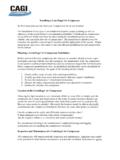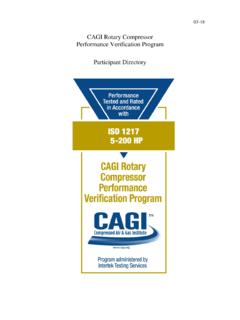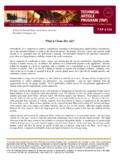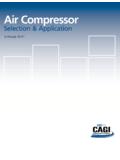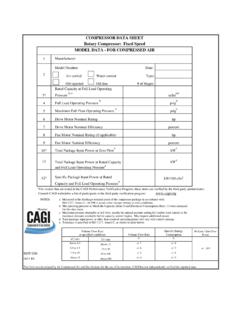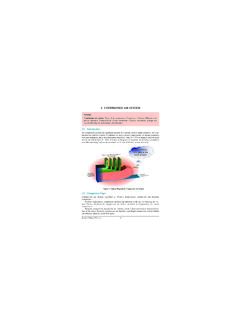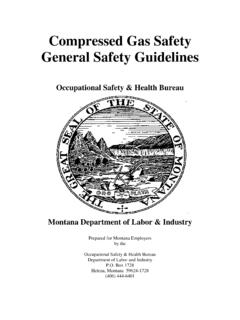Transcription of Compressed Air System Design 4 - CAGI
1 Compressed Air & Gas Institute 1300 Sumner Avenue Cleveland, OH 44115 Phone: 216/241-7333 Fax: 216/241-0105 E-mail: 204 Compressed Air Distribution (Systems)ChApter 44 Compressed Air Distribution(Systems) Compressed Air DiStribution SyStemSWhen a Compressed air distribution System is properly designed, installed, operated and maintained, it is a major source of industrial power, possessing many inherent advantages. Compressed air is safe, economical, adaptable and easily transmitted and provides labor saving power. The cost of a complete Compressed air System and pneumatic tools is relatively small in comparison with the savings effected by their of the Compressed Air Distribution SystemThe primary object of a Compressed air distribution System is to transport the Compressed air from its point of production (compressors) to its points of use (applications) in sufficient quantity and quality and at adequate pressure for effi-cient operation of air tools and other pneumatic devices.
2 However, many other considerations come into the Design of the System to ensure the efficiency and safety of the total System . These will be discussed in this chapter. These include: Air volume flow rate Air pressure requirements Type(s) and number of compressors Air quality Air System efficiency Air System safety Air System layout Air volume flow rate requirementsCompressed Air & Gas Institute 1300 Sumner Avenue Cleveland, OH 44115 Phone: 216/241-7333 Fax: 216/241-0105 E-mail: 205 Compressed Air Distribution (Systems)Air Volume Flow rate requirementsThe proper capacity to install is a vital and basic question and often misunder-stood. The capacity rating of air compressors generally is published in terms of free air, which is at atmospheric conditions of pressure, temperature and relative humidity and not at the pressure, temperature and relative humidity required at the air tool or pneumatic device to be operated.
3 The Applications chapter of this book contains many illustrations of current uses of Compressed air power. The air tools chapter also provides much useful information on applications of air powered tools and other pneumatic study of air-operated devices in a typical manufacturing plant will show that some of these devices operate almost constantly while others operate infrequently but may require a relatively large volume of air while in use. It also will be found that the amount of air actually used by the individual devices will vary considerably in different applications. The total air requirement therefore should not be the total of the individual maximum requirement but the sum of the average air consumption of each. Sufficient controlled storage capacity of Compressed air also is essential to meet short-term high volume for efficient components for the Compressed air System have been discussed in earlier chapters.
4 This chapter deals with the Compressed air distribution System which feeds the production operation. Proper Design of the distribution System is essential to avoid energy waste and to ensure proper use of all pneumatic of the average air consumption is facilitated by the use of the concept of load factor. Pneumatic devices generally are operated only intermit-tently and often are operated at less than full load capacity. The ratio of actual air consumption to the maximum continuous full load air consumption, each measured in cubic feet per minute of free air, is known as the load factor. It is essential that the best possible determination or estimate of load factor be used in arriving at the plant capacity items are involved in the load factor. The first is the time factor, which is the percentage of work time during which a device actually is in use.
5 The second is the work factor, which is the percentage of the air required for maximum possible output of work per minute that is required for the work actually being performed by the device. For example, the air consumption of a grinder with full open throttle varies considerably, depending on how hard the operator applies the grinding wheel against the work piece. The work factor also is affected by the sys-tem operating pressure. For example, a System pressure of 125 psig will provide a work factor 22% higher than a System pressure of 100 psig. (See Table ). The work factor therefore is the ratio (expressed as a percentage) of the air consumption under actual conditions of operation, to the air consumption when the tool is fully loaded. The load factor is the product of the time factor and the work factor.
6 In one plant studied, the air actually consumed by 434 portable air tools on production work was only 15% of the total rated full time air consumption of all the Air & Gas Institute 1300 Sumner Avenue Cleveland, OH 44115 Phone: 216/241-7333 Fax: 216/241-0105 E-mail: 206 Compressed Air Distribution (Systems)ChApter 4In designing an entirely new Compressed air distribution System , it is highly desirable to utilize experience with a similar plant. The established load factor can be used as the basis of a good estimate for the new System . A log of pressures throughout an existing facility will reveal trends, including peaks and lulls in demand and potential irregularities to be avoided in the new System . Another source of this type of information is the manufacturer of the air tools and pneu-matic devices , shows the maximum air requirements of various tools and can be used for preliminary estimates.
7 These figures are approximate and individual tools from different manufacturers may vary by more than 10% from the figures given. Since load factor may vary considerably from one plant to another, any general figures should be used with caution. For example, one manufacturer states that the compressor capacity should be about one third of the requirement of all the pneu-matic tools. See Table It is recommended that the manufacturer of each air tool, device or machine, be consulted as to recommended requirements. Table should not be used for constant demand applications, including sandblasting requirements shown in Table Air & Gas Institute 1300 Sumner Avenue Cleveland, OH 44115 Phone: 216/241-7333 Fax: 216/241-0105 E-mail: 207 Compressed Air Distribution (Systems)table Air Requirements of Various ToolsTool Free Air, cfm at 90 psig, 100% Load Factor Grinders, 6" and 8" wheels 50 Grinders, 2" and 2 1/2" wheels 14-20 File and burr machines 18 Rotary sanders, 9" pads 53 Rotary sanders, 7" pads 30 Sand rammers and tampers, 1" x 4" cylinder 25 1 1/4" x 5" cylinder 28 1 1/2" x 6" cylinder 39 Chipping hammers, weighing 10-13 lb 28-30 Heavy 39 Weighing 2-4 lb 12 Nut setters to 5/16" weighing 8 lb 20 Nut setters 1/2" to 3/4" weighing 18 lb 30 Sump pumps, 145 gal (a 50-ft head) 70 Paint spray, average 7 Varies from 2-20 Bushing tools (monument) 15-25 Carving tools (monument)
8 10-15 Plug drills 40-50 Riveters, 3/32"-1" rivets 12 Larger weighing 18-22 lb 35 Rivet busters 35-39 Wood borers to 1" diameter weighing 4 lb 40 2" diameter weighing 26 lb 80 Steel drills, rotary motors Capacity up to 1/4" weighing 1 1/4-4 lb 18-20 Capacity 1/4" to 3/8" weighing 6-8 lb 20-40 Capacity 1/2" to 3/4" weighing 9-14 lb 70 Capacity 7/8" to 1" weighing 25 lb 80 Capacity 1 1/4" weighing 30 lb 95 Steel drills, piston type Capacity 1/2" to 3/4" weighing 13-15 lb 45 Capacity 7/8" to 1 1/4" weighing 25-30 lb 75-80 Capacity 1 1/4" to 2" weighing 40-50 lb 80-90 Capacity 2" to 3" weighing 55-75 lb 100-110 table Cubic Feet of Air Per Minute Required By Sandblast Compressed Air Gage Pressure (psig) Nozzle Diameter 60 70 80 100 1/16" 4 5 3/32" 9 11 12 15 1/8" 17 19 21 26 3/16" 38 43 47 58 1/4" 67 76 85 103 5/16" 105 119 133 161 3/8" 151 171 191 232 1/2" 268 304 340 412 Compressed Air & Gas Institute 1300 Sumner Avenue Cleveland, OH 44115 Phone: 216/241-7333 Fax: 216/241-0105 E-mail.
9 208 Compressed Air Distribution (Systems)ChApter 4 For tools used regularly on one operation, a study of active and inactive times may be made. Judgement may be exercised at this time as to the work factor to be applied if other than unity. If air requirements of a manufacturing process are evaluated on the basis of unit production in cubic feet of free air per piece pro-duced, they may then be combined on the basis of total production to arrive at the average volume rate of air pieces of production equipment are actuated by pneumatic cylinders. These include automatic feed devices, chucks, vises, clamps, presses, intermittent motion devices, both reciprocating and rotary, door openers and many other devic-es. Such devices usually have low air consumption and are themselves inexpensive.
10 They find increasing use in automated production processes. Air con-sumption for such cylinders is shown in Table This table shows only the theo-retical volume swept out by the piston during one full stroke, which must be con-verted into a flow rate of free air. Many cylinders contain air cushioning chambers which increase the volume somewhat over the tabled figures. In addition, in actual use the air pressure to the cylinder may be throttled to a pressure considerably below the System line pressure. If a limit switch cuts off the air supply when a certain force is exerted by the cylinder, the corresponding pressure should be cal-culated and used rather than full line pressure in converting the tabled figures to free air conditions. In many applications the full available piston stroke is not needed.


